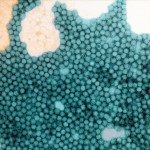Lien vers Pubmed [PMID] – 9454713
Virology 1998 Feb;241(1):14-29
After 2.5 months of persistent infection in human neuroblastoma cells by the type 3 poliovirus (PV3) wild-type Leon strain, a mutant (PVpi), L2-2, capable of establishing a persistent infection in nonneural HEp-2c cells was isolated. Sequence analysis of the viral capsid protein genes revealed the presence of seven missense mutations, three of which were also present in a second PVpi, suggesting that they could be important determinants of the persistent phenotype. When the three mutations were introduced into the lytic Leon strain separately, in pairs or all together, all but one of the viruses was capable of establishing a persistent infection. However, aside from the triple mutant, only one mutant virus, bearing a Leu at position VP213 in the capsid interior and an Asn at position VP1290 on the capsid surface, was capable of establishing persistent infections in more than 30% of the cultures. When present together, these two determinants affect the early steps of the virus cycle including cell binding and the receptor-mediated conformational changes believed to be necessary for viral penetration and uncoating. In fact, this persistent double mutant appears to undergo a novel capsid transition when in contact with the human PV receptor, altering from the native virion which sediments at 160S to a form which sediments at about 147S. We propose that this modification could be the mechanism by which PV3 is able to establish persistent infections in HEp-2c cell cultures.
